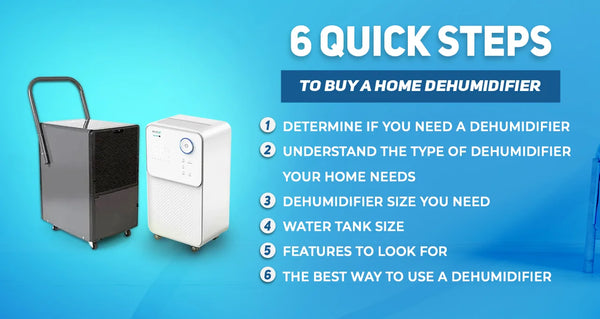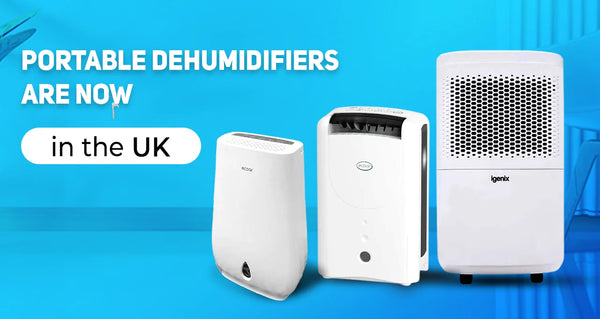A Comprehensive Guide to Buying a Home Dehumidifier: 6 Quick Steps

Are you struggling with dampness in your home interior? It is so obvious that autumn and winter in the UK come with high humidity up to 80% to 90%, which means there's too much moisture in the air and poor ventilation, resulting in condensation. And, your daily activities like cooking, drying clothes, showering and heating add more humidity to your interior. That’s why the chances of damp buildup and black mould increase.
No idea what to do? Well, the smartest step you can take is to buy a portable home dehumidifier to avoid dampness and make your home cosy to live in. And, if you don’t know how to choose a perfect dehumidifier for your home, here’s the guide you need!
How to Buy a Perfect Portable dehumidifier for Your Home
Autumn in the UK is usually wet and cold, causing high humidity and condensation, resulting in dampness and mould. Ignoring them can cause damage to your home, health and possessions, such as mildew spots on the walls, wallpaper peeling, rotting wood and much more. Placing a portable dehumidifier in your room can actually save you.
But, to buy the right dehumidifier for your home, here’s what you need to check:
#1: Determine If You Need a Dehumidifier-
Mildew spots on the walls, musty smell, watermarks in basements or wallpaper peeling- all these may look like signs of needing a dehumidifier. But, it's not necessary every time. Instead, you should test the humidity of your home first using a hygrometer to ensure the humidity level, which shouldn’t be more than 30% to 50% in any season. If the humidity is above 50%, get a dehumidifier and try to eliminate the root cause of humidity.
#2: Understand The Type of Dehumidifier Your Home Needs-
Whether searching online or in the market, you will find two different types of dehumidifiers- Compressor and Desiccant.
Compressor dehumidifiers have a fan to draw in air and pass it through the cold coils inside, where water condenses on the coils and drips the moisture into the water tank. Lastly, reheat the air and pump back warm and dry air in your rooms. It’s more energy-efficient compared to desiccant ones. Here are the most popular compressor portable dehumidifiers are now in the UK:
- Fral FDND33 33L Heavy Duty 33L Compressor Dehumidifier
- Igenix IG9813 12L Low Energy Dehumidifier
- EcoAir Summit - S 12L Compressor Dehumidifier
- EcoAIR DC18 Mk 2 18L Compressor Dehumidifier
On the contrary, Desiccant dehumidifiers absorb all the moisture from your interior air using a desiccant chemical to pass the wet air drawn by the fan. And, the moisture observer slowly rotates the wheel, and its other part heats the air to drip out the moisture in the water tank. Finally, pump the warm air inside your room that reduces humidity. These dehumidifiers are lighter and quieter than compressor models. Among the best ones in the market, here are some:
- DD3 CLASSIC MK3 11L Desiccant Dehumidifier With Antibacterial Nano Filter
- DD1 Classic MK6 BLACK 7.5 Desiccant Dehumidifier With Ioniser And Nano Filter
- Dehumidifier Prem-I-Air EH1384 50L
- DD128 BLUE 8L Desiccant Dehumidifier With Ioniser And IonPure Filter
#3: Dehumidifier Size You Need-
In this case, size means the amount of moisture a dehumidifier can eliminate from your interior air in a day. For a domestic model, it usually comes in a variety of sizes, from 7.5 litres to 20 litres, whereas for commercial uses, there are up to 50 litres.
You need to select the capacity size based on your requirements. For instance, if you need to dehumidify a small single room, the smallest size is sufficient, whereas to dry out a large room, it’s better to go for a dehumidifier of 10 to 20 litres.
However, it also depends on the dampness of your home and the temperature.

#4: Water Tank Size-
It’s another feature you need to consider to ensure how fast it fills up with moisture and how regularly you have to empty it. The larger the tank is, the less often you will have to unload it. Or else, buying the accurate size may make you vacant the tank more often. However, most desiccant and compressor dehumidifiers come with drainage hoses that operate the water tank constantly, which cuts the worries of filling the tank quickly.
#5: Features to Look For-
Whether choosing a desiccant or a compressor dehumidifier, you need to go down to the details, like the features, to determine which type is best for your home. For example:
- Portability
- Noise level
- Laundry mode
- Continuous drainage hose
- Electrical control panel, including auto shutoff, sleep mode, auto defrost, timer, and much more
- Anti-bacterial filter
- Child lock
#6: The Best Way To Use a Dehumidifier-
Before buying a portable home dehumidifier, you should know how to use it to get the most out of it. For instance, when drying out a room for the first time, you need to use it for long hours, from almost an entire day, and even several days sometimes, depending on its capacity. And, when the humidity level of your room reaches the standard one, using the dehumidifier for two to four hours is sufficient.
However, you don’t need to use a dehumidifier all around the year. It depends on the condition of your home. Just turn it on when you find the humidity level of your home is rising.

Explore the Best Portable Dehumidifier in the UK Right Here
At BRIGHT AIR, we have a huge collection of desiccant and compressor portable home dehumidifiers available at competitive ranges. Whether looking for domestic dehumidifiers or commercial ones- We have got you all covered. You can have a cosy and comfortable home free from dampness and mould all year. Shop now!

